‘Hot Zone’ recreates 2001-era ‘NBC Nightly News’ set, other parts of 30 Rock
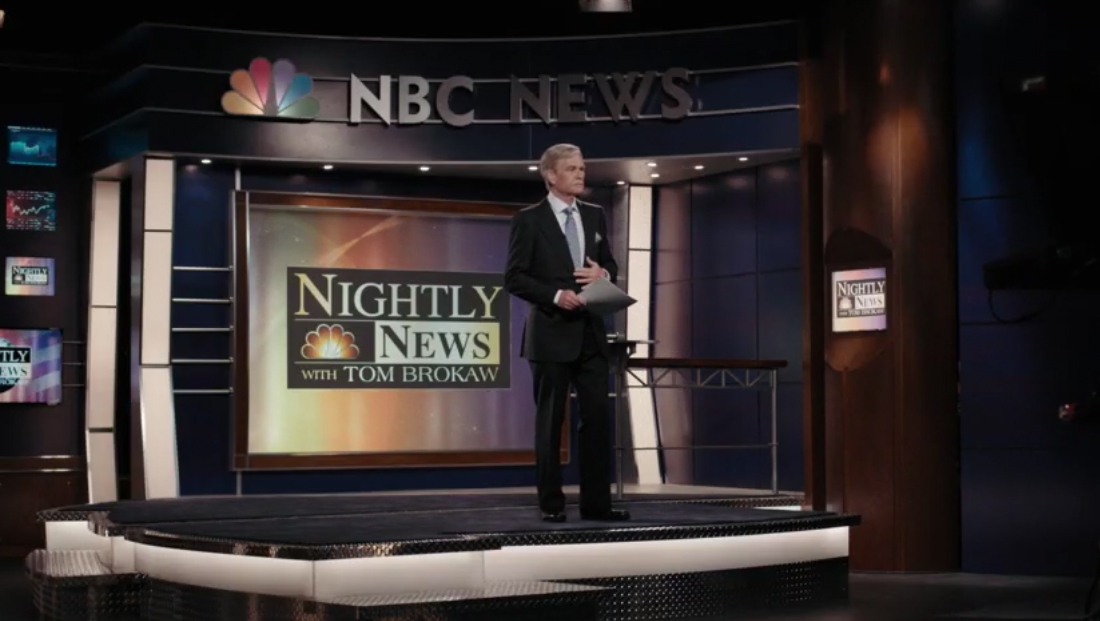
Subscribe to NCS for the latest news, project case studies and product announcements in broadcast technology, creative design and engineering delivered to your inbox.
The National Geographic miniseries “The Hot Zone: Anthrax” follows the story of a string of 2001 mailings containing a deadly bacteria sent to prominent politicians and media organizations, including NBC News, which lead producers to build a recreation of the “NBC Nightly News” set of that time.
Just about a month after the Sept. 11, 2001 terror attacks, letters containing a white powder later determined to be anthrax began arriving via mail at major media outlets and members of Congress.
Infections at ABC, CBS and National Enquirer publisher AMI lead investigators to believe they received letters laced with anthrax, even though they were never found. The New York Post also received a letter that was confirmed to have anthrax in it, but no one was infected.
NBC News, however, was thrust into the spotlight because of a letter addressed to then-“NBC Nightly News” anchor Tom Brokaw was opened by staffer Casey Chamberlain and then passed along to Brokaw’s assistant Erin O’Conner. Both women later fell ill but survived.
Chamberlin later recalled opening a letter that had a powder in it. She brushed the powder into the garbage and put the letter in a pile that eventually was handed over to O’Conner. It is presumed that trace amounts of the spores remained on the paper and envelope.
In “Hot Zone,” actor Harry Hamlin portrays Brokaw and multiple scenes show him on the “Nightly News” set and in various workspaces around 30 Rockefeller Plaza, the headquarters of NBC News.
The series managed to recreate a very close rendition of the set “Nightly” was using at the time, located in what was then known as Studio 3C.
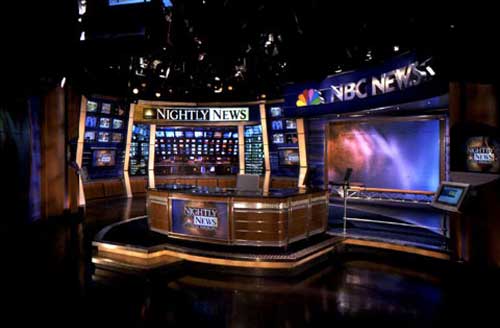
The ‘NBC Nightly News’ set that was in use in October 2001, when the events of ‘Hot Zone: Anthrax’ took place.
The “Nightly” set at the time was designed by PDG, which Jack Morton Worldwide later acquired, and featured multiple rear projection screens and cubes as well as integrated monitors and a movable anchor desk that could “dock” with a riser in front of the area Brokaw typically opened the broadcast from at the time.
In 2001, rear projection screens and cubes were the only practical way to create large backdrops that could be changed dynamically. They typically were rather small, due to technical limitations involving throw distance and projector brightness, a big different in the seamless LED video panels used today.
“Nightly” had switched to having Brokaw stand for select segments, including the top of the show, going back to when it originated from Studio 3B across the hall on the set it shared with other NBC News productions, including “Dateline NBC.”
This set, when “Nightly” left it, also included a rear projection wall built from cube-style RP units that was added in the mid-1990s, replacing a wall with a smaller projection screen set inside slanted panels with reveal lines.
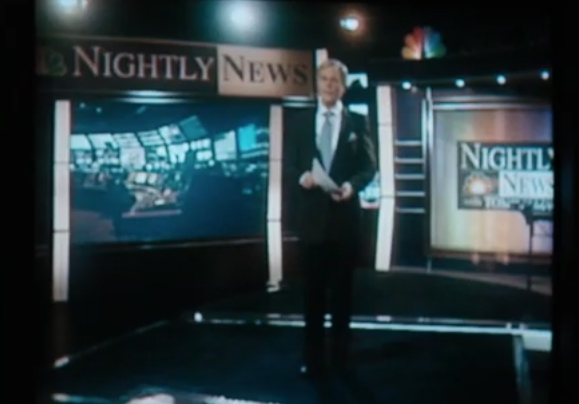
The 2001-era “Nightly” set combined a rear projection screen between two slanted, internally lit columns, along with a stack of cube RP units on either side. More cube RPs were installed above to create a header.
The lower portion of this wall could show a video loop based on actually footage captured at the then-MSNBC studios and NBC News main newsroom in Secaucus, New Jersey. The cubes above showed the date in the opens and other branding elements throughout the newscast.
For some segments, including the “In Depth” block the network aired at the time, this entire wall showcased topical graphics instead of the control room, with an “In Depth” logo fed to the header.
“Hot Zone” recreates the control room look in some scenes, though it’s a decidedly light and off axis shot then what was actually used.
On either side of this wall on the real set were two additional walls with nine video screens arranged in a 3×3 pattern and a flat screen below. In “Hot Zone,” the are only four monitors above in a 2×2 arrangement.

3C’s anchor desk was also recreated with a fairly close rendition and one of the wood toned columns with integrated monitors that was part of the set at the time is also shown. This element, like the angled internally lit columns, was inspired by elements on the set in 3B.
The column, which rarely appeared on air during this time, is missing a the second video panel that was installed below the top one.
It does not appear that “Hot Zone” recreated any of the set that existed camera left of the zones shown, which included an additional rear projection cube wall and column with monitors — though these were rarely seen on air either.
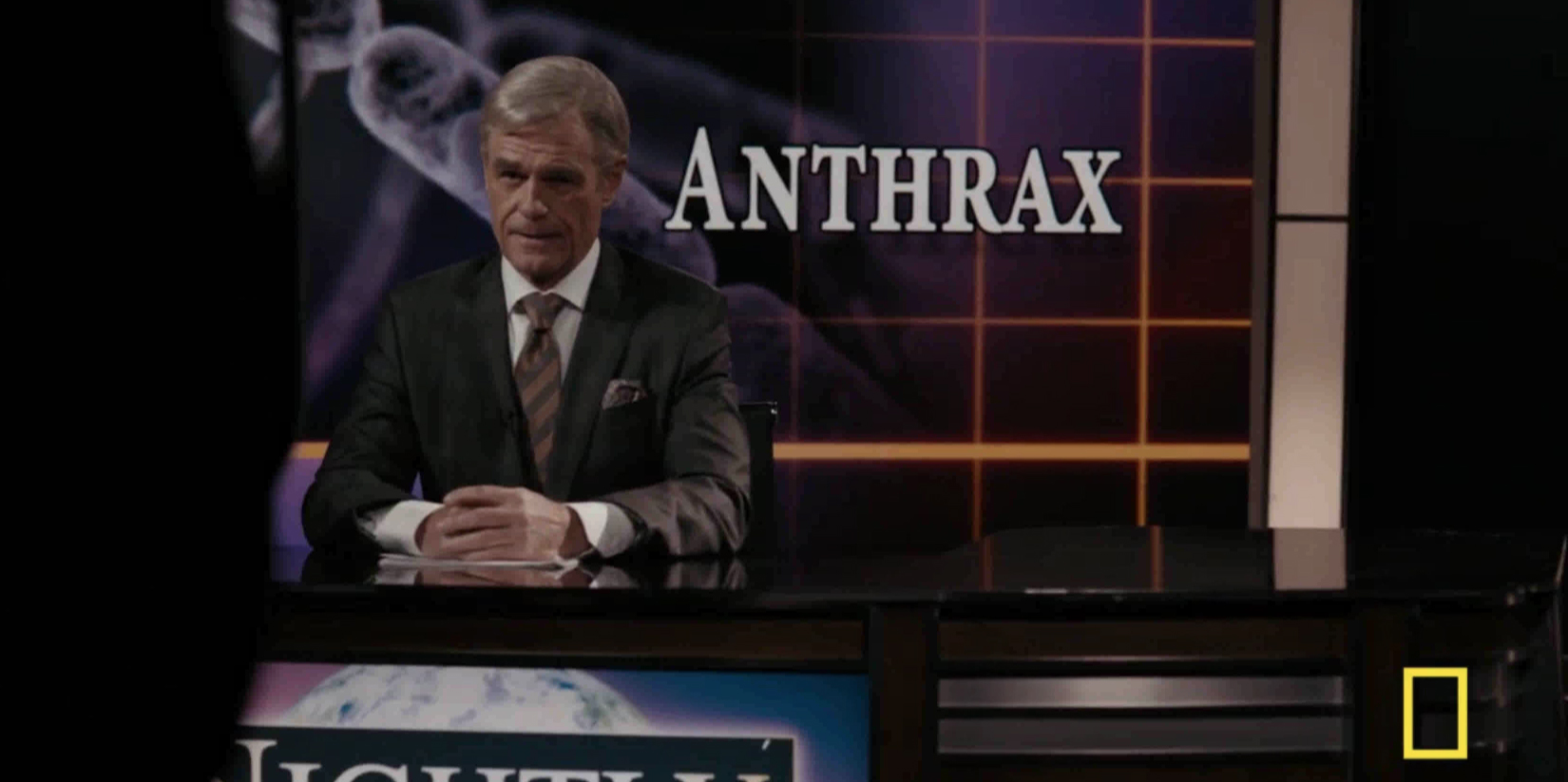
In one scene, Hamlin as Brokaw is depicted in front of a background with a recreation of the graphic the network used in 2001 — though it shows the word “anthrax” camera right when it was camera left on the real broadcast.
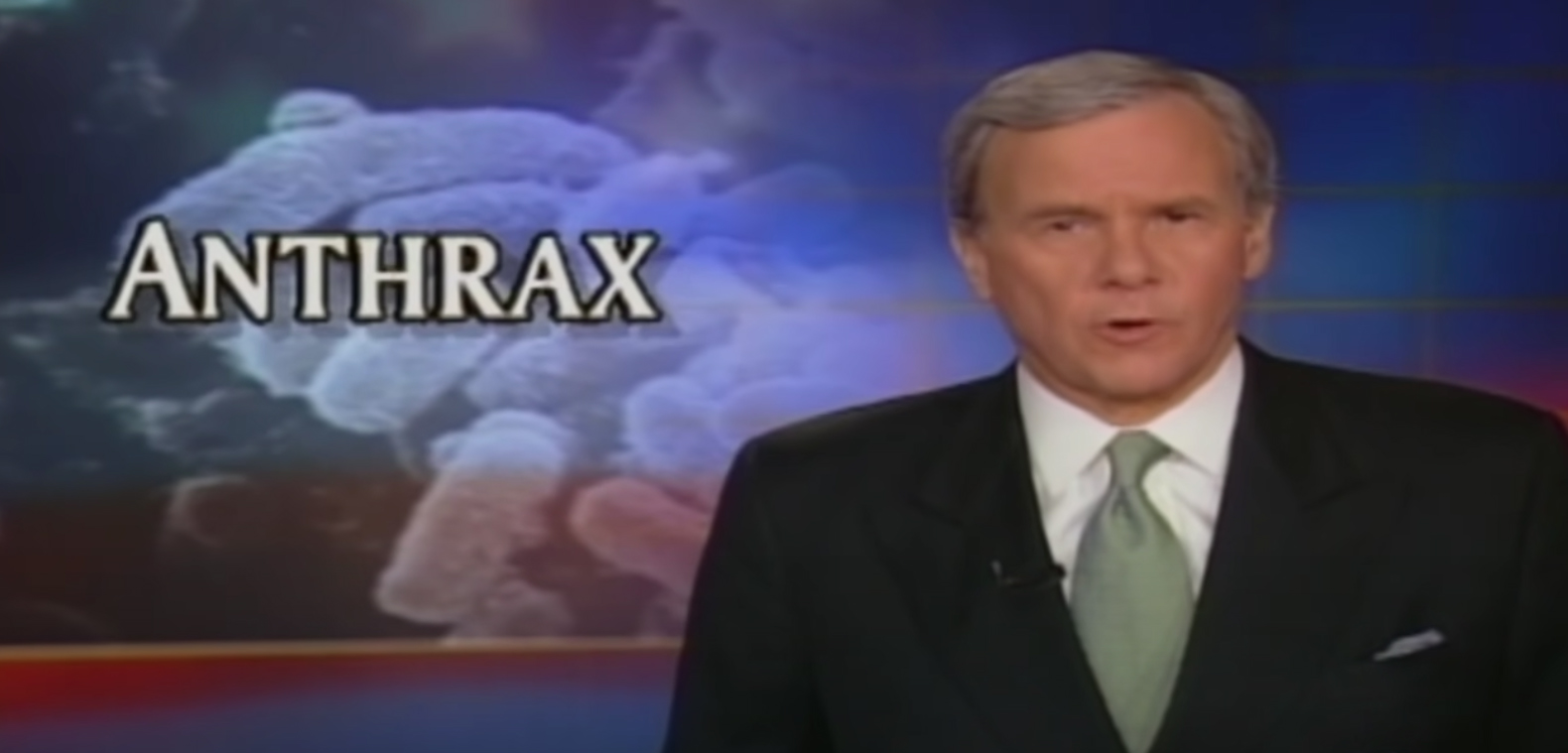
Some subtler details, such as a notably different font and much more exaggerated gridline background are noticeable as well.
Getting really nit-picky is the fact that the word “Anthrax” is shown, in “Hot Zone,” as being part of the graphic shown on the RP behind Brokaw.
At the time, however, “Nightly” typically inserted typography and any imagery it wanted to be more prominent over the camera feed rather than embedding them in the RP video feed.
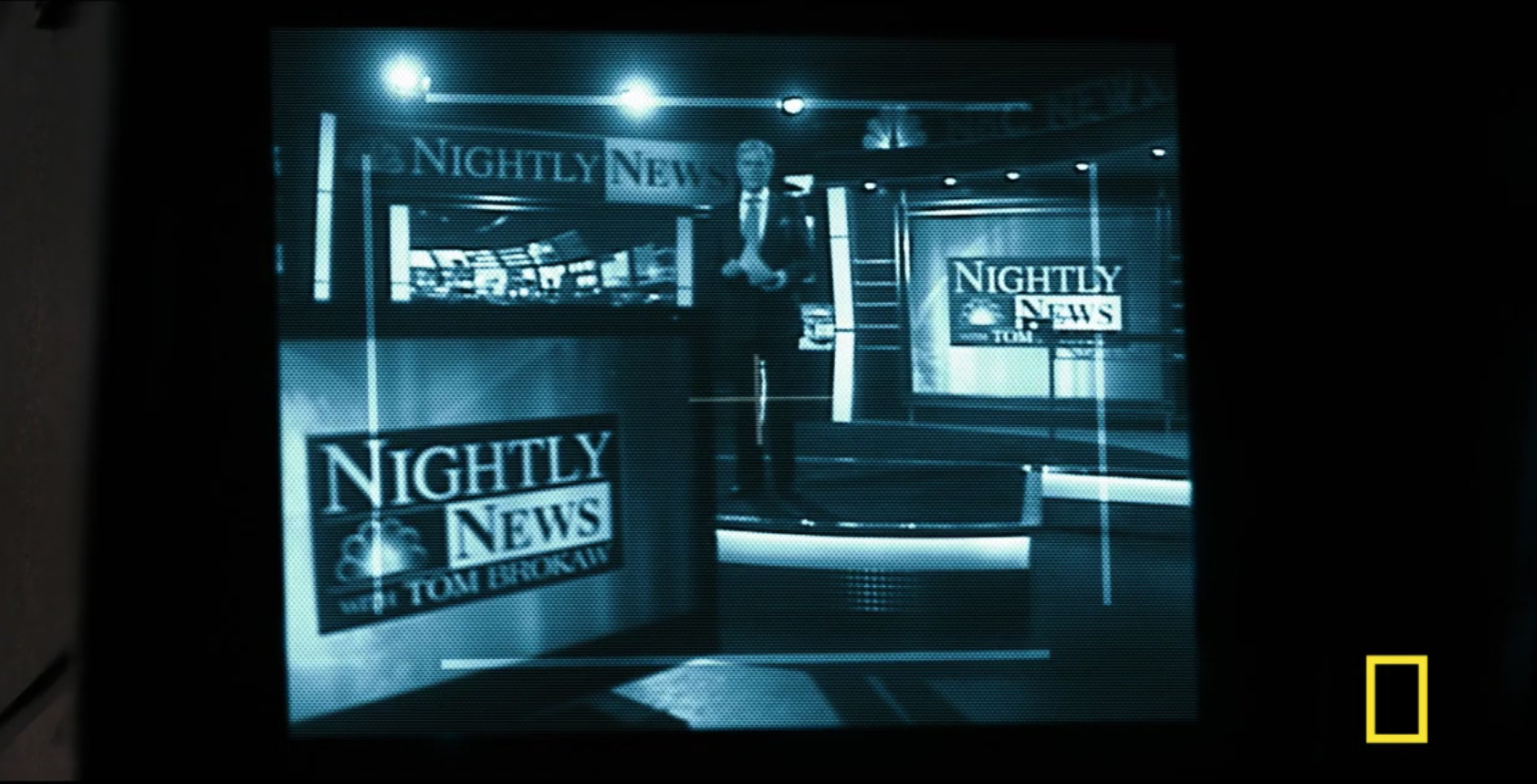
In this shot of a camera viewfinder, ‘Hot Zone’ gets the opening shot of ‘NBC Nightly News’ circa 2001 very close, right down to the monitor showing the show logo in the lower left. NBC typically showed the date in the video cubes along the top of the set rather than the ‘Nightly News’ logo at the time, however.
Some other details “Hot Zone” didn’t quite get right include some of the graphics used throughout the show, including the lower thirds.
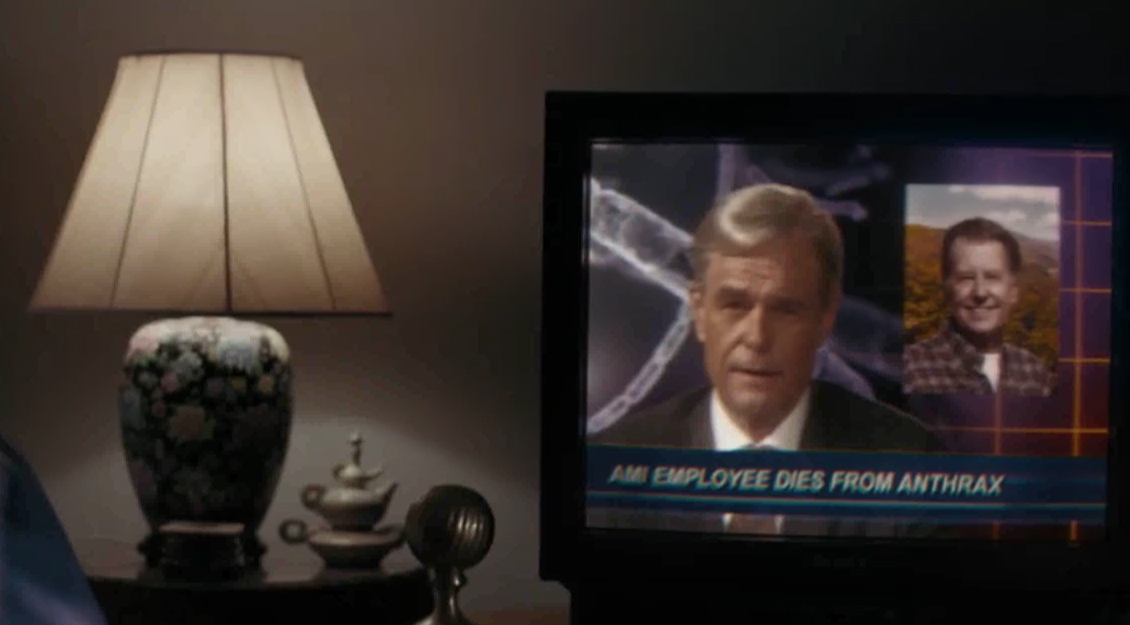
The insert graphics shown on television monitors in “Hot Zone” feature a blue gradient with all caps, italic banner with a single line of text.
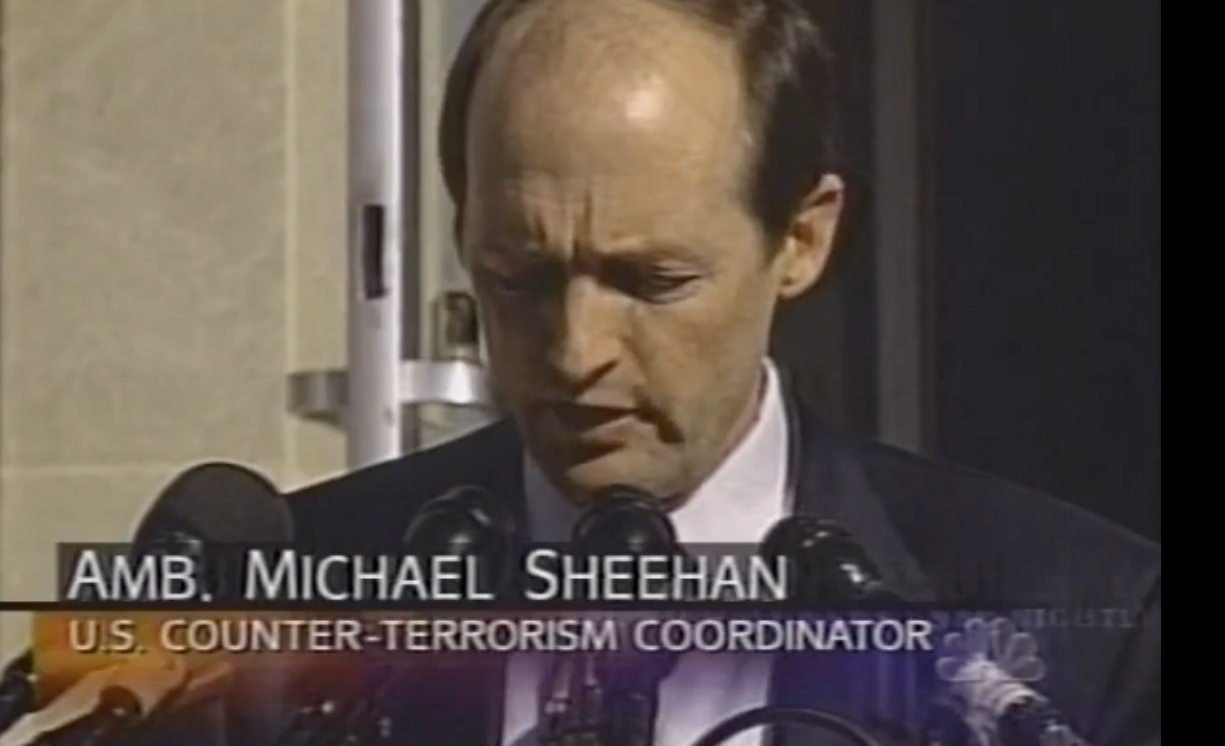
However, “Nightly” had introduced new graphics along with the new set that featured a boxed first tier and second tier in a gold and purple gradient that matched the rest of the graphics package.
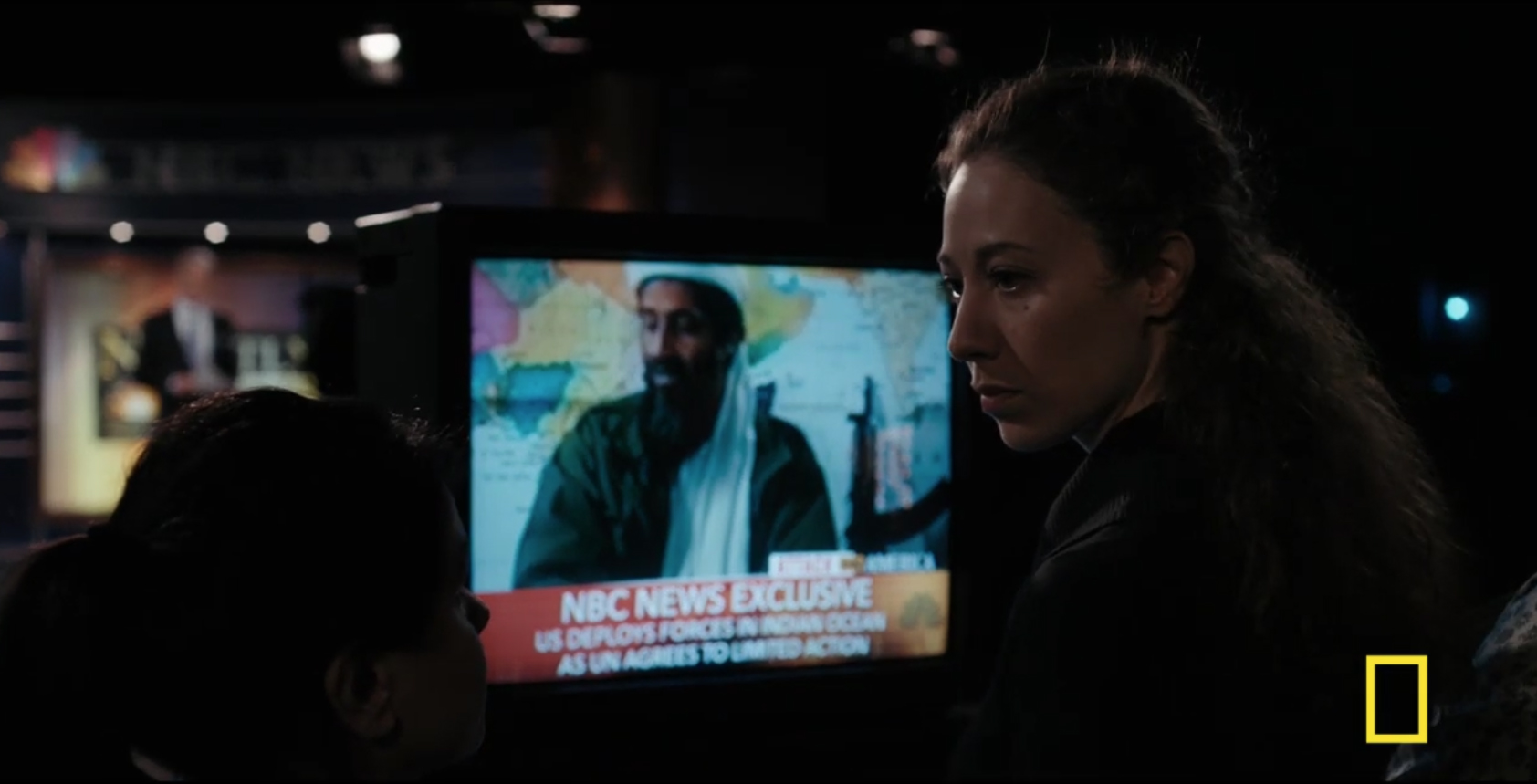
At one point, Hamlin as Brokaw tosses to a package from “Michael Smith” and on set return monitors show video with a red and yellow lower third with centered graphics, which appears to be more remiscient of the network’s 9/11 special report look at the time.
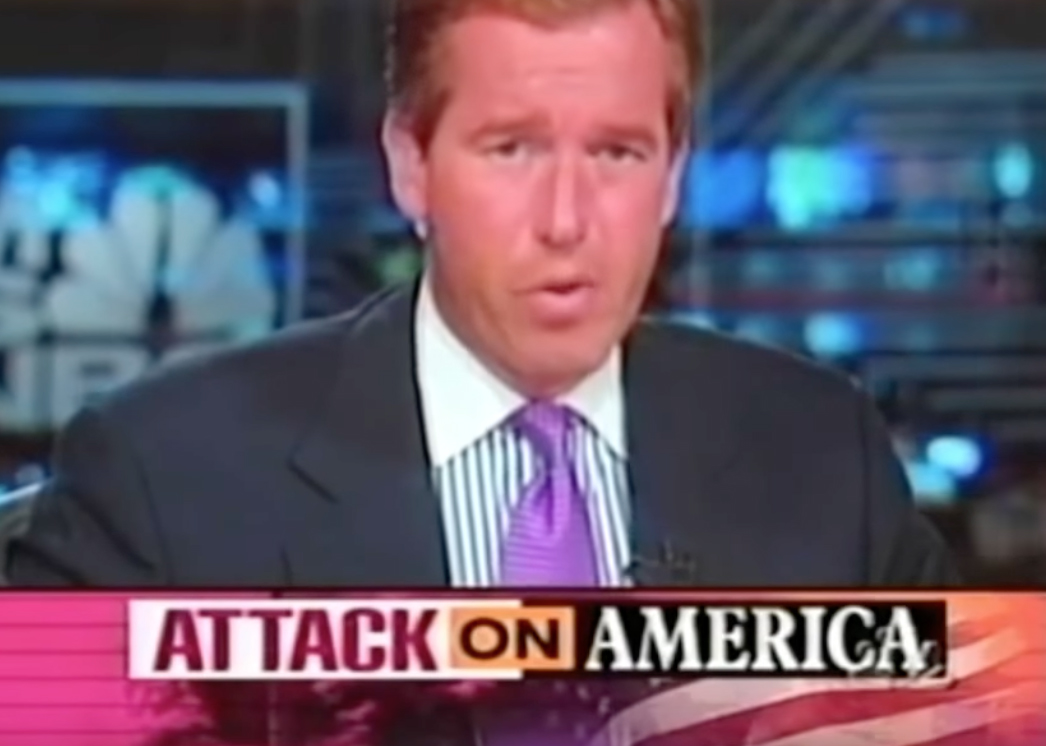
However, the boxed “Attack on America” in the upper right of this lower third does closely match the look NBC was using at the time for terrorism related coverage.
“Hot Zone” did attempt to recreate the vertical burst of color on the graphics frequently used on the rear projection screen backgrounds though the look didn’t feature the horizontal bursts of light as prominently.
One big discrepancy, however, is that Hamlin, as Brokaw, is shown on the 3C set announcing the news that one of the network’s own staffers had been infected with anthrax.
In reality, this broadcast was Oct. 12, 2001, by which time NBC and officials had evacuated the third floor of 30 Rock where the “Nightly” set and newsroom were.
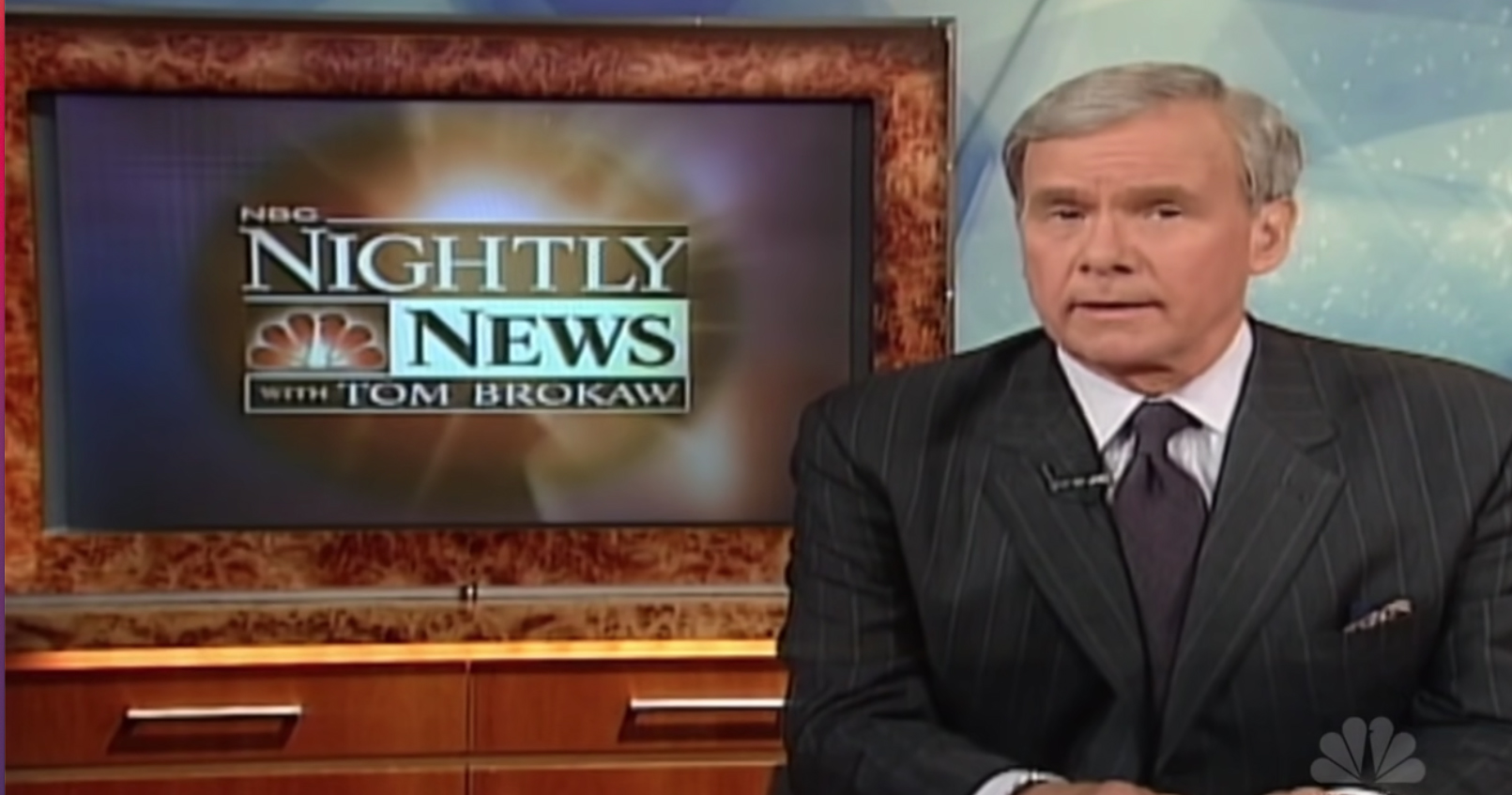
Brokaw anchored the Oct. 12 broadcast from the news desk in Studio 1A, home of “Today” and located across the street from 30 Rock. Technically 1A is in the building known as 10 Rockefeller Plaza and although the buildings are connected underground, it was presumably determined to be safe to use that facility instead.
Brokaw would continue anchoring from 1A for the next week or so as a massive decontamination process was done on the studios and work areas across the street.
In addition to Studio 3C itself, “Hot Zone” also featured scenes of Brokaw and staffers walking down a long hallway to access the studio, which is very much like it is in 30 Rock, though the ceilings in the series hallway appear to be higher than in real life.
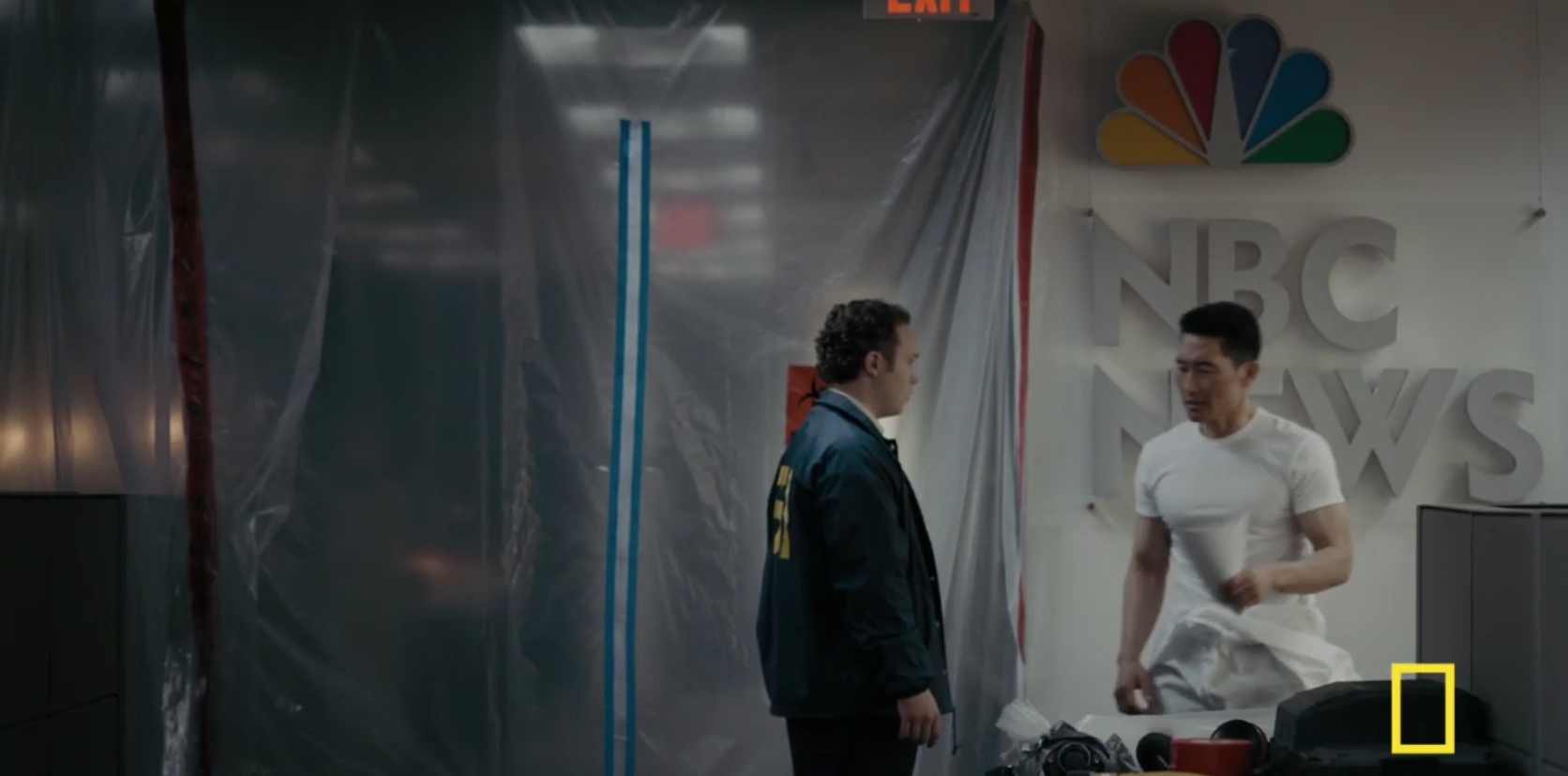
This scene, showing a cordoned off workspace, features a large NBC News logo on the wall.
Also depicted were various workspaces throughout 30 Rock, including a mailroom facility, though these spaces were largely depicted in what could be the interiors of almost any large office building.
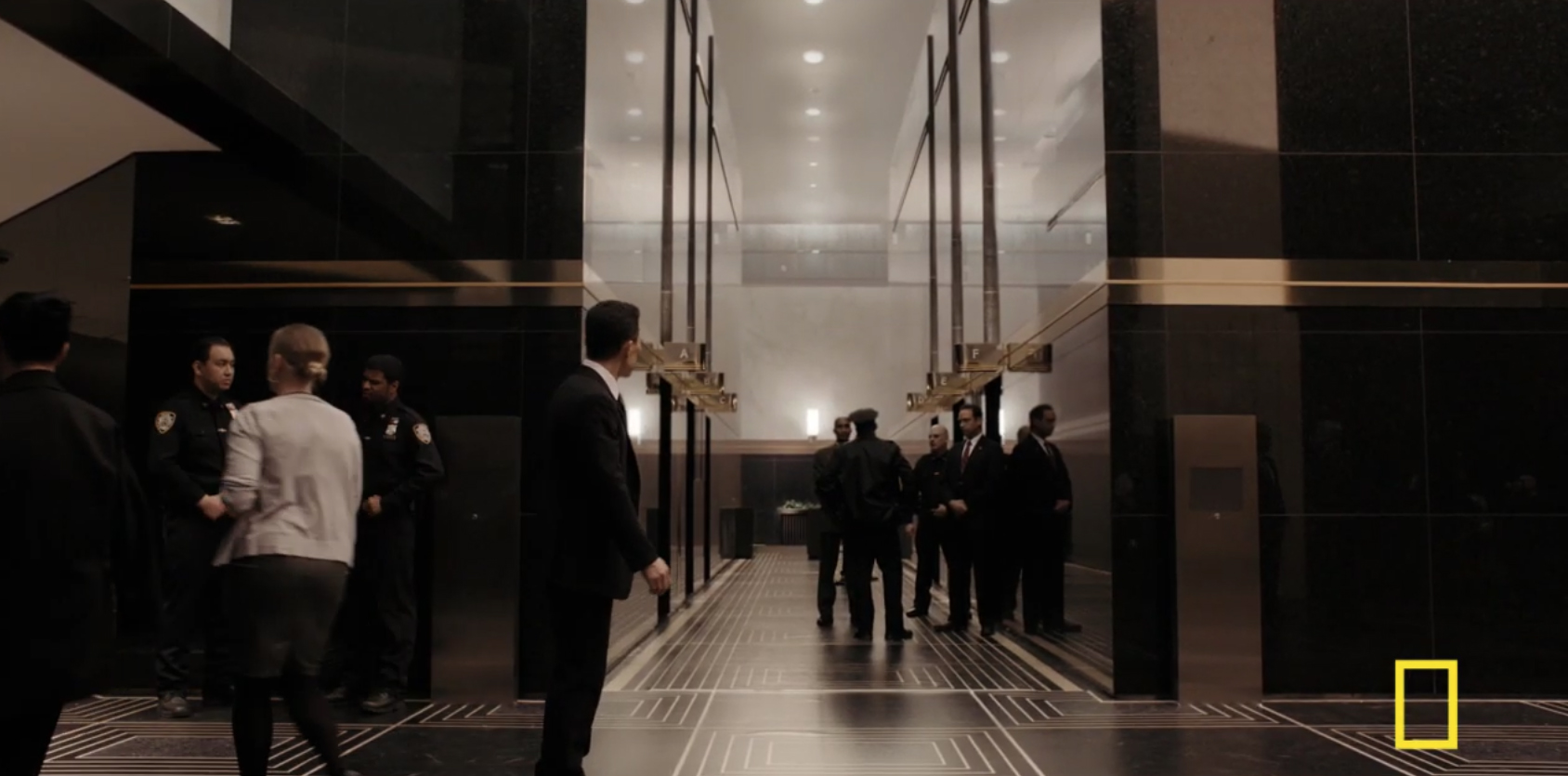
The series also featured scenes set in the lobby of 30 Rock, mostly showcasing an elevator bank with an art deco look that includes flooring that has a similar pattern to that found in the real lobby. Also of note is the dark, glossy look that is found in the real building as well.
One scene was also set in an ABC News newsroom. ABC and CBS were also represented in the series through the use of actual footage taken from their broadcasts around the same time, with Dan Rather and the late Peter Jennings appearing as themselves on their “real” sets. Other clips included footage taken from CNN.
“Hot Zone” did not recreate any sets for either ABC or CBS (a much less detailed effort to create the “CBS Evening News” set in use around 2001 was attempted in 2015 film).
Since 2001, “NBC Nightly News” has moved around inside 30 Rock and gone through multiple sets.
During a 2007 renovation, Studio 3A and 3C were significantly updated. The two spaces were located on the same side of the hallway, but NBC enlarged both spaces and combined them, making them immediately adjacent to each other, separated by glass.
One side was primarily used as a studio for MSNBC while also serving as a newsroom, while “Nightly News,” now anchored by Brian Williams, used a smaller space that overlooked the newsroom area and other set.
“Nightly” would then move back to 3B, with WNBC taking over 3C with a completely new set.
Eventually, however, “Nightly” returned to the space known previously know 3C (the studio officially lost the 3C designator in favor of sharing “3A” with the neighboring MSNBC studio, but is sometimes referred to as 3C and 3AW) with a fresh new look and remained there until September 2021, when it moved across the street to 1A.
Subscribe to NCS for the latest news, project case studies and product announcements in broadcast technology, creative design and engineering delivered to your inbox.




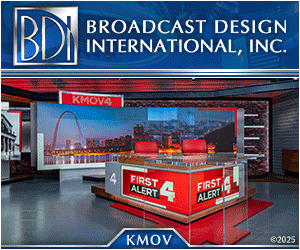


tags
National Geographic, NBC, NBC News, NBC Nightly News, Studio 3C
categories
Broadcast Design, Broadcast Industry News, Featured, TV Show Production Design